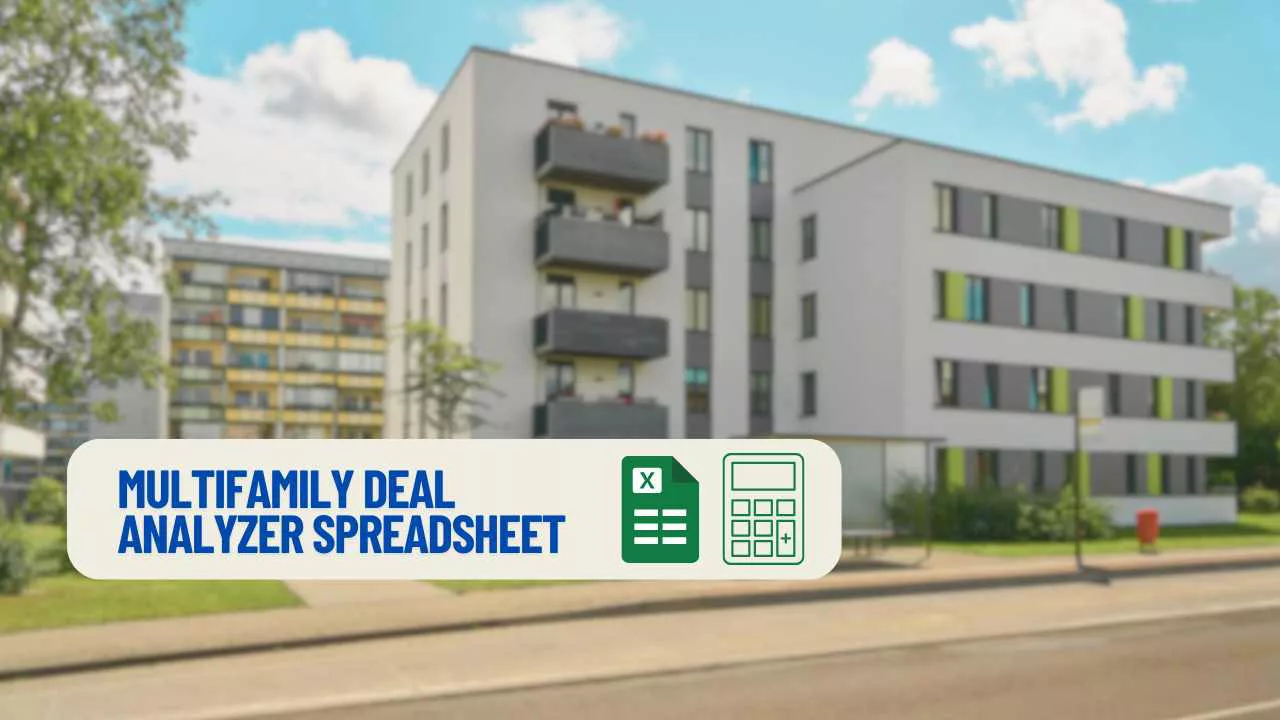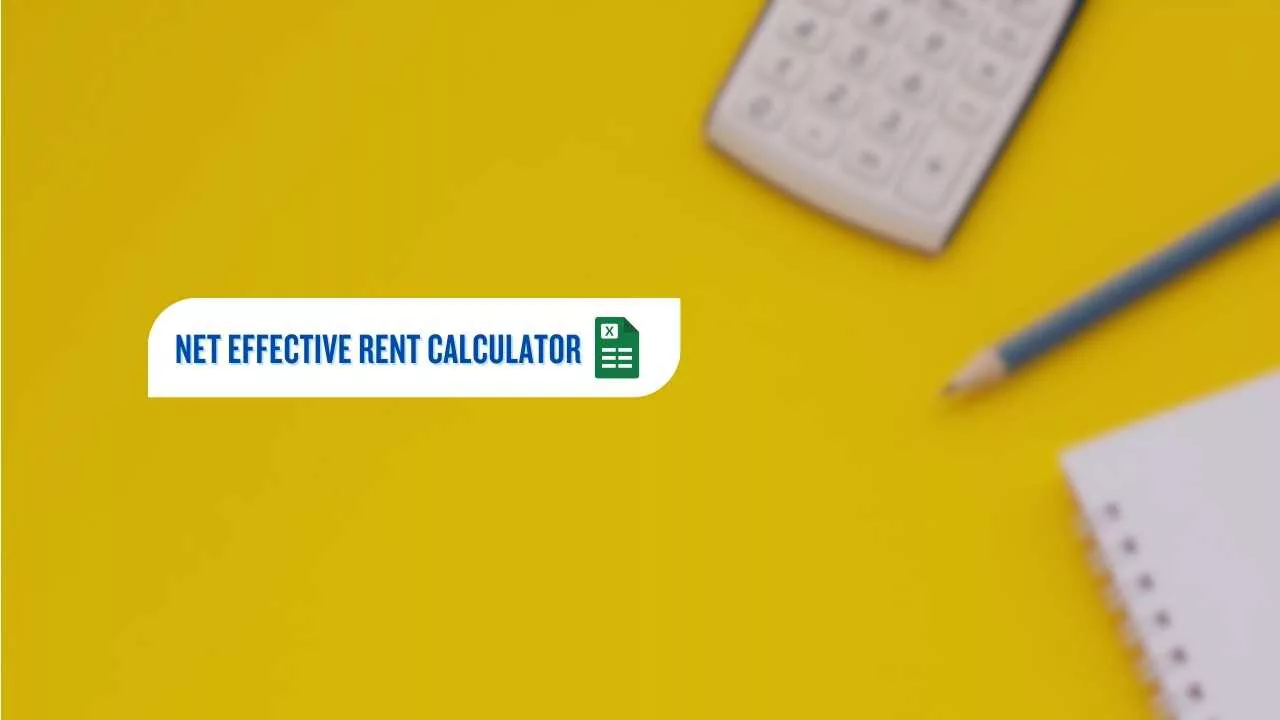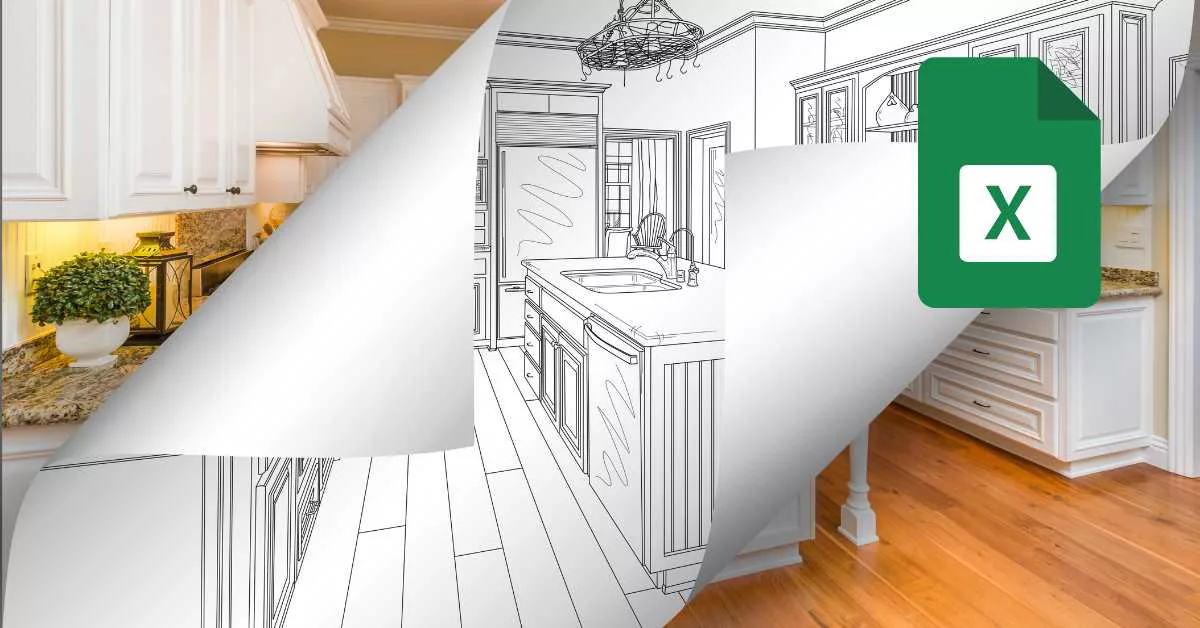Scroll Down for a Free Multifamily Deal Analyzer Spreadsheet
TL;DR: Looking for a fast way to analyze multifamily deals? This free spreadsheet helps you estimate ROI, cap rate, cash flow, and expenses, just plug in property and loan info to get instant investment metrics.
Many real estate investors make the mistake of leaping into an opportunity without fully qualifying a multifamily property. If you’re serious about building wealth, you need to know that every dollar counts. I created this free multifamily property analyzer spreadsheet to take the guesswork out of evaluating properties and help you make data-backed decisions.
Get the Free Analyzer – Excel & Google Sheets
What’s the Best Way to Analyze a Multifamily Deal?
Analyzing a multifamily property requires a structured approach that combines market research, financial evaluation, and risk assessment. Here’s a breakdown of the key steps.

Step 1: Define Your Investment Strategy
Start by clarifying your objectives. Are you targeting “value-add” opportunities or stable, income-producing properties? Define your target property class (A, B, or C) and tenant demographic to align the deal with your goals.
Step 2: Conduct Market and Financial Analysis
Evaluate the local market by looking at population growth, employment rates, and local amenities. Use our on-page calculator below to run the numbers, including gross rental income, property expenses, and Net Operating Income (NOI).
Multifamily Deal Analyzer
For informational purposes only. Not financial advice.
Step 3: Assess the Risks
Every investment carries risk. Conduct a thorough inspection to identify any deferred maintenance or structural issues. It’s also important to have a clear exit strategy and understand how market changes could impact your investment over time.
You never want to lose a piece of property in Buy and Hold real estate. That is how you truly build wealth… you have to find a deal that cash flows day one.
Intro to How we analyze a multifamily deal 0:00 you never want to lose a piece of 0:01 property and Buy and Hold real estate 0:03 that is how you truly build wealth and 0:05 real estate today we’re talking about 0:07 how to assess a deal and this could be a 0:09 pretty short video today because it’s 0:10 actually ridiculously simple so we’re 0:12 going to roll right into it Welcome to 0:15 our Channel 0:17 [Applause] 0:17 [Music] 0:19 welcome back this is Cody I’m here with 0:21 my buddy Christian and today we are 0:24 talking about how to underwrite and 0:25 really just assess if you should buy a 0:27 piece of real estate now there’s only 0:29 three things you got to think about Are you going to hold the property forever? 0:30 number one would you like to hold it 0:32 forever we don’t like to sell real 0:34 estate we’re not flippers I’ve done a 0:36 flip he’s done a flip we made multiple 0:39 six figures between the two of those and 0:41 it was a great deal however I wish I 0:43 could have held the real estate would 0:44 have made a lot more in the long term 0:45 and that’s usually the case for most 0:47 people that sell real estate so would 0:49 you envision yourself owning this in 30 0:51 40 50 years 0:53 if the answer is yes then we proceed to 0:55 number two which is can you buy it which How do you buy your next multifamily deal? (what is the actual deal) 0:59 is really how do you buy it deal that 1:01 Equity you find a deal then you locate 1:03 the debt and then you figure out the 1:04 equity it’s one thing to Envision 1:06 yourself owning something forever that’s 1:08 great but in practical application you 1:11 have to find the deal that you want to 1:12 buy then you have to be able to line up 1:14 the debt and the equity and the last 1:15 piece is you have to make sure you never 1:17 lose it yep you never want to lose a Never Lose your real estate 1:19 piece of property in Buy and Hold real 1:21 estate that is how you truly build 1:22 wealth in real estate you can’t lose it 1:25 because then you have to start all over 1:27 again that’s not fun yeah not fun at all 1:29 how you lose it is simply we need to 1:31 find a deal that cash flows day one 1:32 that’s the first and foremost if it 1:34 makes money much easier to hold than 1:36 something that loses money buy and lose 1:37 real estate is not as fun as Buy and 1:40 Hold so that’s the cash flow well now 1:42 what are we looking at next it has to be 1:44 long-term debt if I have a great cash 1:46 flowing deal and I have a 90-day loan on 1:49 it I can probably afford to hold that 1:50 deal for about 90 days oh good math 1:53 I could do about 90 days to hold the 1:56 length that is really important so we 1:58 have long term cash flowing next thing 2:01 and this so many people forgot this 2:03 fixed rate debt you cannot have debt Fixed rate debt 2:06 that just changes people love variable 2:08 rates oh you sure can it just won’t go 2:10 well well yeah I mean you can 2:11 technically do it is it a good idea also 2:13 no 2:14 um so with the fixed rate what you’re 2:16 doing is you’re eliminating variables 2:17 you’re going I am fixing my costs so 2:19 that I know that cash flows now at this 2:20 number I’m getting fixed rate debt over 2:22 a long period of time which means 2:24 everything’s constant 2:26 if I am not a good operator I can 2:28 improve cash flows potentially lower 2:30 expenses and it will just do better and 2:33 better and better 2:34 what I don’t want to do is halfway 2:36 through my loan have like we just had 2:38 happen a lot of people on interest rates 2:40 go from three and a half to eight 2:42 percent on variable interests I had that 2:45 happen on a HELOC in my house where I 2:47 went from five to eight not a loser yeah 2:49 fortunately it was a hundred thousand 2:51 dollar loan in our 12 million dollar 2:53 debt portfolio that being said that 2:55 hundred thousand 2:57 I I’m like wow my payments really went 2:59 up can you imagine if you’re one of the 3:01 people who will hold a hundred million 3:02 dollar loans and they’re out there I 3:04 know of a few I won’t name drop here but 3:06 you have hundreds of millions in debt 3:08 and it all of a sudden went from three 3:10 to eight percent 3:11 game over you lose start over from 3:14 square one yeah buy and lose real estate 3:16 yeah that’s a strategy but that’s as 3:18 simple as it is you have to have assets 3:19 that you want to hold forever that’s the 3:21 other I think that’s the one other thing 3:22 you really it’s 3:25 yeah and that is what I want to end on 3:27 that is the main thing is do I want to 3:30 hold it forever yeah follow the rest of 3:32 the steps make sure you can hold it 3:33 forever and that you would like to hold 3:35 it forever then you just have to sell 3:36 for how do I buy it how do I never lose 3:37 it will it be fun because if it’s not 3:39 fun you’re not going to want to hold it 3:39 forever and then you become like a 3:41 flipper and everybody flips tends to 3:43 regret it and that’s it like subscribe 3:45 for more 3:47 [Music] 3:58 thank you 4:00 [Music]
How This Analyzer Compares to Other Templates
| Feature | This Spreadsheet | Other Free Templates |
|---|---|---|
| Cash-on-Cash Return | ✅ | ❌ |
| Google Sheets Compatible | ✅ | ⚠️ Only Excel |
| Cap Rate Calculation | ✅ | ✅ |
| Loan & Refinance Details | ✅ | ❌ |
Check Back for Updates on How To Analyze Multifamily Investment Opportunities
As real estate investors continue seeking better tools to evaluate every potential multifamily investment, this resource will evolve to meet their needs. Whether you’re analyzing a multifamily property deal or expanding a larger real estate portfolio, updated features will help you dive deeper into a property’s net operating income, property valuation, and property’s cash flow. Our upcoming enhancements will guide you through understanding a property’s rent roll, mortgage expenses, and property management costs, crucial factors when trying to increase net operating income. You’ll also be able to benchmark against comparable properties, gain insight into the multifamily asset class, and identify which multifamily real estate investments align best with your investment portfolio and long-term goals. If your objective is to make smarter decisions, gain tax benefits, and improve returns on a rental property, make sure to check back often as we refine our multifamily deal analysis system to help you analyze multifamily investment opportunities with clarity and precision.
Frequently Asked Questions
Net Operating Income (NOI) is your property’s gross income minus all operating expenses. Cash-on-Cash Return is your annual pre-tax cash flow divided by the total cash you invested. Our spreadsheet calculates both of these automatically for you.
Yes! This analyzer is perfect for any multifamily property, from duplexes and triplexes to larger apartment buildings. Simply adjust the “Unit count” in the calculator to match your property.
About the Author

Joseph E. Stephenson, REALTOR®
License #00054082 | Kansas & Missouri
Affiliated with Welch & Company (License #CO00000477)
Joseph E. Stephenson is a licensed real estate professional in Kansas and Missouri with a career built on dedication to integrity and client-focused service. To learn more about how Joseph can assist you in your real estate endeavors, visit his REALTOR® profile at realtor.com.
Verify Joe’s Real Estate License Credentials
Real Estate Agent License VerificationVerify Joe’s Business Credentials
Joseph E. Stephenson also operates a business named Stephenson Residential, LLC. You can verify the business at the Kansas Secretary of State’s website.
Verify Business Credentials




